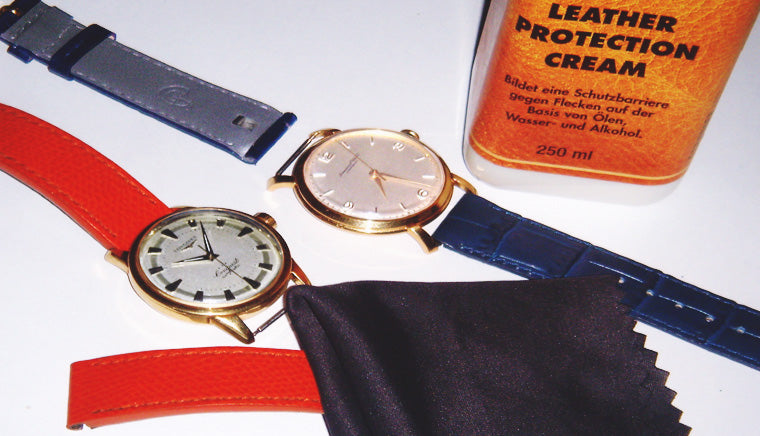General
Different materials require different care. However, to make your strap last, gentle and kind care goes a long way rather than the quick solutions, like heat drying of a wet leather strap. In any case be very cautious with the use of solvents – they are generally NOT recommended with the exception perhaps of all-metal bracelets.
All cleaning should be done on the strap once it has been removed from the watch to prevent damage to a non-water proof watch.

Leathers
Generally avoid liquid contamination of any kind even though when straps are labeled as water resistant. It is best to err on the side of caution, particularly when it comes to solvents, wine, sauces etc.
The first step should always be to pat-off the strap using a soft dry piece of cotton cloth. Pay particularly attention to the liner as it tends to absorb some of the sweat and the skin’s oils.
For heavily dirtied straps use a soft, moistened cloth next that feels humid to the touch but is not dripping and wipe your strap gently. Do not use paper tissue or kitchen papers as the fibers in paper tend to scratch the leather surface microscopically.
Do not force dry using a hair dryer or placing the strap on top of a radiator as this will over time make the leather brittle and thus shorten its life considerably.
For very wet liners you may pat down the liner using blotting paper to soak up much of the moisture.
Occasionally it may be useful to add a tiny drop of leather conditioner onto the top leather. Do not apply to Suede or Nubuk as it will discolor your fine strap!
Synthetics
Since the surface of synthetics is closed (unlike the pores in leather), rinsing under a water faucet and using a soft-bristle brush like an old toothbrush can do the job perfectly well.
However, if the surface has a matte finish it may be preferred to use a cloth rather than a brush to prevent the appearance of shiny patches on the strap.
Some patterns on the liner side of synthetic straps tend to accumulate skin debris, which are best removed either by using the old toothbrush or for the more patient owners a toothpick could be used.
Never use any solvents like alcohol, ether, chlorine etc. At the most us suds prepared from a mild baby soap in small amounts.
Metals
Depending on the type of surface, different methods should be used to assure a long life of your bracelet. Since bracelets are typically assembled from different links they tend to accumulate debris, skin particles and oils mixed with airborne dust at their internal junctions. These are best removed by submerging the bracelet only – not the watch – into a ultrasonic cleaner with its prescribed cleaning solution.
Most owners do not have access to this tool and so the second best alternative is to rinse the bracelet under a water faucet and use a soft brush to gain as much access to the tiny spaces between the links.
